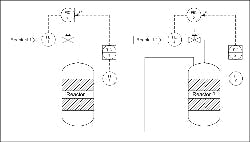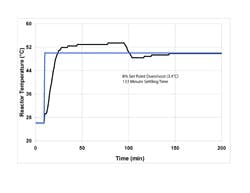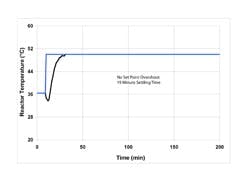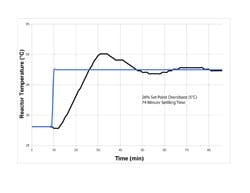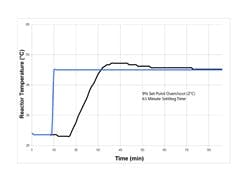The nonlinear dynamics of most exothermic and endothermic batch reactions require expert attention to assure quality production. For instance, introducing reactants often results in dramatic swings in temperature. Maintaining production tolerances in such an environment tests the effectiveness of any proportional-integral-derivative (PID) controller and the associated tuning parameters.
As a global leader in specialty chemicals, Evonik Industries AG understands the economic implications of good versus poor control of batch processes. Headquartered in Essen, Germany, the company produces a wide spectrum of polyamides, coating adhesives and other specialty chemicals. It maintains operations in more than 100 countries; it has more than 25 production facilities in the U.S., including Evonik Jayhawk Fine Chemicals in Galena, Kan. The management team at Galena has been implementing cutting-edge control technologies that are significantly reducing production cycle times and increasing the plant’s overall profitability.
The Galena facility manufactures pharmaceutical intermediates, specialty chemicals and herbicides, and industrial solvents. One of the production processes has two exothermic reactions that are regulated via a cascaded temperature-to-flow control architecture (Figure 1). Unlike most batch reactor processes, control is managed through adjustments to reactant flow. The primary control loop maintains reactor temperature within a range of 48°C to 52°C. The secondary loop adjusts the rate of reactant flow into the process. This architecture enables Evonik to meet the process’ tight temperature tolerance and operating specifications.
Figure 1 -- Cascade control:
Adjustment of reactant flow
regulates the reactor temperature.
Click on illustration for a larger image.
However, dramatic changes to temperature regularly occurred as reactant was introduced, creating the equivalent of a process upset and resulting in frequent overshoot. Oscillations within the process were such that the production cycle was longer than necessary, averaging 27 hours.
Startup Challenges
Without operator intervention, during startup the process would overshoot as the reactor warmed up (Figure 2a). This and other process dynamics proved difficult for plant staff to control. Manual PID tuning failed to achieve the desired results.
Evonik hoped that commercial tuning packages could accurately model the batch dynamics. However, using most such software tools posed a major problem.
Almost every commercial PID tuning package requires an initial steady-state operation. By beginning at a steady state, these tools establish a known value of operation that becomes the basis for application of their respective modeling algorithms. Bump tests then generate dynamic process data that these tuning packages use to model the relationship between the controller output and the measured process variable (PV). The software relies on that relationship to calculate tuning parameters for the PID controllers.
Figure 2 -- Better startup: (before, top; after, bottom)
PID control eliminated set-point
overshoot and cut settling time to
one-seventh of that with manual control.
Click on illustrations for larger images.
Achieving and maintaining steady-state operation is challenging in a real plant environment, which is inherently dynamic due to its hundreds or even thousands of interacting PVs. Ensuring that all elements of a production process are “quiet” and stable prior to and during bump testing often is impractical and sometimes impossible. In addition, the need for steady-state operation prior to the performance of dynamic bump tests can significantly impact a facility’s economics by decreasing throughput, reducing quality, increasing off-specification production, wasting feedstock and human resources, and incurring other expenses.
The Solution
To avoid these issues, Evonik turned to Loop-Pro tuning technology from Control Station, Inc., Tolland, Ct. Version 5, officially released in July 2008, features a patent-pending “Non-Steady State Model Fitting Innovation” (NSSMFI). This breakthrough eliminates the requirement for steady-state operation prior to the performance of bump tests.
Control Station’s approach doesn’t utilize a specific data point or average data point as a “known” and, therefore, isn’t constrained by it. Rather, the NSSMFI adjust the model to fit across the entire range of data under consideration rather than linking it to a specific starting point. So, Loop-Pro can consider all possible model adjustments and optimize the model’s fit relative to all of the data under analysis. This freedom results in a model that more accurately describes the full range of dynamics within a process because it goes beyond simply characterizing the initial reaction to a bump test. It also supports more rapid optimization of a facility’s PID controllers as users no longer have to wait for a process to steady out before beginning their bump tests.
The Galena facility, which already had been using Loop-Pro, upgraded to Version 5 upon its release. Installation and activation of the software was completed in minutes; Control Station’s solutions engineering team provided web-based training that equipped Evonik with the know-how to effectively apply the technology. Using bump-test data from a data historian, plant staff successfully tuned a variety of control loops in a matter of hours. For example, it took under one hour to analyze and tune the cascade loops. Similarly, less than three hours were needed to bump the process and improve the associated controller’s performance.
Figure 3 -- Disturbance rejection: (before, top;
after, bottom) Changing from manual to PID
control enabled the secondary loop to better
buffer the impact of upstream disruptions on
the primary loop.
Click on illustrations for larger images.
With the introduction of tuning parameters from Loop-Pro, simple PID controllers for the cascade loop effectively eliminated the overshoot problem and dramatically decreased settling time (Figure 2b). The plant documented a 9.3% reduction in production cycle time on each of the two batch reactors tuned in the month of August — this 2.5-hour decrease includes a 30-minute drop in the feed cycle.
Manual tuning of those loops had been challenging under normal conditions. With an oversized valve in place, Evonik staff were hard pressed to determine good tuning parameters and to control oscillations within the process. Loop-Pro V. 5 produced tuning parameters that accurately characterized the dynamics of both the process and the oversized valve. The result was faster settling time and, more importantly, control within the process’ required range of operation (Figure 3).
In August, the software tool was used to successfully diagnose and optimize other systems across the facility, including control loops associated with venting, conductivity, level and temperature.
Loop-Pro has provided significant financial benefits, thanks to the faster batches. Additionally, manual operation during startup is no longer required. Widespread application of Loop-Pro technology at the site is expected to further enhance both productivity and profitability. In the hyper-competitive specialty chemicals market, these changes are welcome news for Evonik and the Galena staff.
John Gaines is a senior controls engineer for Evonik Jayhawk Fine Chemicals, Galena, Kan. Dennis Nash is president and CEO of Control Station, Inc., Tolland, Conn. E-mail them at [email protected] and [email protected].

